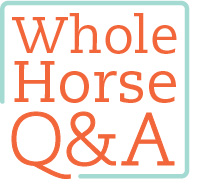Q I run a small boarding business. A new boarder owns a 5-year-old Paint gelding with PSSM, and his diet has to be managed. What exactly is this condition, and can he be cured?

KATIE MOORE, California
A Polysaccharide storage myopathy (PSSM), a muscle disease in horses, has two types. Type 1 is found in more than 20 breeds and commonly affects Quarter Horses; Quarter Horse-related breeds, such as Paints and Appaloosas; Morgans; some draft breeds; and some warmbloods. Type 2 is found in Quarter Horses, Arabians, Thoroughbreds, and potentially other light breeds.
PSSM is characterized by the abnormal accumulation in muscle tissue of a normal form of sugar (glycogen) and an abnormal form (polysaccharide). Both Type 1 and Type 2 are related to this accumulation of muscle glycogen, which is the storage form of glucose in muscles (see box).
Horses with either form of PSSM have signs typically associated with what’s commonly called “tying-up”: muscle stiffness, sweating, and reluctance to move. These signs most often appear when horses go into initial training or return to work after a lay-up.
Episodes usually begin after light exercise, such as 10 to 20 minutes of walking and trotting. Symptoms may also occur without exercise. Most horses with the condition have a history of repeated episodes of muscle stiffness at the commencement of training; however, mildly affected horses may have only one or two episodes per year.

Carbohydrates high in starch—such as sweet feed, corn, wheat, oats, barley, and molasses—appear to worsen both types of PSSM and should be avoided. Provide extra calories in the form of fat, instead. Gradual introduction of exercise is essential, and a daily exercise program enhances glucose use and improves energy metabolism in skeletal muscle. Research shows that when only the diet is changed, only about 50 percent of horses improve. But if both diet and exercise are altered, 90 percent of horses experience no or few subsequent tying-up episodes.
Horses with PSSM can’t be cured, but they can be managed through diet and exercise. Severity of symptoms vary widely. Some affected horses are readily managed, but a few persist with repeated episodes of muscle pain. Also, because Type 1 PSSM is inherited as a dominant trait, horses with it have at least a 50-percent chance of passing it on to offspring.
STEPHANIE VALBERG, DVM, PhD, DACVIM
Professor, Large Animal Medicine
University of Minnesota Equine Center






